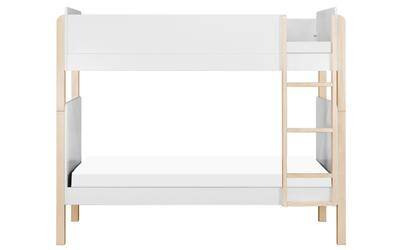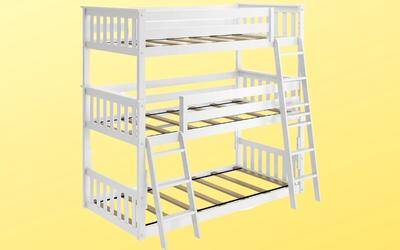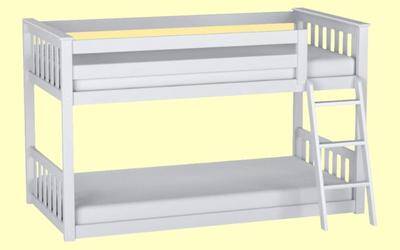TheRoundup is reader supported. We may earn a small commission when you make a purchase via links on this site, at no cost to you.
All products are personally reviewed and tested in accordance with our Review Methodology.

Do you have children who share a bedroom? Are you looking for a safe and non-toxic bunk bed option for them? If so, your search could finally be over...
I recently helped out an old college buddy whose 6-year-old twins were ready to transition into ’big boy beds’, and was looking for a safe, sustainable and affordable solution.
Finding the perfect GreenGuard certified bunk beds was harder than I thought. But after much research and testing, I found a bed that meets their needs perfectly, as well as a few close contenders. All of which I’d like to share with you today.
I’ve also got some valuable tips to help you choose the right bed for your family.
So, whether you’re looking for a traditional bunk or something more unique, read on…I’ve got you covered!

✔ Modern Design
✔ GREENGUARD Gold Certified
✔ Sustainable Materials

They Say: Featuring a sturdy integrated ladder that can be placed on either side to work with any room configuration, the Babyletto TipToe Bunk Bed easily converts into two individual twin-size beds. With playful rounded edges and contrasting colors and made with eco-friendly, non-toxic materials, it fits a standard twin-size bed mattress (sold separately, box spring not required).
We Say: If you’re looking for a non-toxic bunk bed that’s both stylish and safe, the Babyletto Tiptoe is the perfect option!
This bed is made with sustainable materials. I love the use of responsibly sourced solid New Zealand pine and TSCA-compliant engineered wood.
These superb sustainable materials are finished with a non-toxic paint and stainer process.
All this means that this bunk bed has been certified as safe by GREENGUARD Gold. Giving you true peace of mind that no nasty VOCs are entering your child’s bedroom.
The Babyletto Tiptoe is a versatile piece of furniture that easily converts into two twin beds.
The ladder is easy to climb and can be placed on either side, making it suitable for any room configuration.
I’m mightily impressed with the quality of the construction. It feels very sturdy, and I have no hesitation in making it my overall winner.

✔ Best Top-End Designer Option
✔ Stylish and Safe
✔ Made from FSC-Certified wood

They Say: The elegant Perch twin-sized bunk bed is the perfect centerpiece for any child’s room. Its compact footprint leaves plenty of room for play and additional furnishings. The versatile Perch easily separates into a twin-sized loft bed and a standalone lower twin bed, giving many configuration options.
We Say: The Oeuf is a stylish and safe option for your children’s bedroom.
It is made of Baltic Birch plywood and eco-MDF, both FSC-certified.
The bed conforms to all applicable U.S. safety standards, with a sturdy frame and solid rails on the top bunk. It also has an angled ladder with a safety tread for safer climbing.
Also, because it is lower than a conventional bunk, it’s easier for children to get up onto the top bunk.
The birch finish with white parts is non-toxic and free of VOC health hazards. And, because the wood wastes and finishing materials are recycled, this is a very eco-friendly bed.
In terms of assembly, this was one of the more challenging beds to build.
I class myself as a competent DIYer and complete 99.99% of my projects on my own. But, this time, I had to borrow Mrs. M’s steady hands a couple of times.
Don’t panic if DIY is not your strong suit, though. For an extra $230, you can have it assembled by an expert.
I love the versatility of this bunk. It can hold 250lbs and can be separated into a twin bed and a twin loft bed. The ladder can also be attached to either side for further versatility.
I do need to address the price tag, though. Almost $2,000 for a child’s bed is definitely on the pricey side!
However, if you have the budget available and are looking for the very best in design and safety, then this is the bunk bed for you.

✔ Made from Solid Pine
✔ Triple-Decker Option
✔ Perfect Space-Saver

They Say: With minimal footprints, Max & Lily bunk beds are great for smaller rooms. They have 14-inch tall guard rails, fit standard-sized mattresses up to 8 inches thick, and don’t require a bunkie board or box spring.
We Say: The Max & Lily Triple Bunk Bed Frame is an excellent choice for children who need a sturdy and safe sleeping solution.
The bed is made of solid wood (New Zealand Pine) and finished with a low-VOC finish, giving you peace of mind that your little ones won’t be breathing in toxic fumes in their sleep.
The minimalist design comes in a neutral white color. It’ll look great in any type of bedroom.
It has full-surround rails to keep your child safe while sleeping on the upper or lower levels.
This excellent bunk bed has a weight capacity of 400lbs, making it sturdy enough to hold toddlers to teens.
I love the flexible design, which means the bunk can easily be separated into three free-standing beds.
One minor niggle I have is not to do with the bunk bed itself but with the delivery. It arrived in multiple boxes over a few days. Not the most eco-friendly system!

✔ Affordable Budget Non-Toxic Frame
✔ Can be Expanded
✔ Removable Slide & Curtain Options

They Say: Max & Lily kids furniture offers stylish and affordable low bunk bed designs with versatile options and add-ons to perfectly fit your needs! Add extra, optional guard rails to the bottom bunk for more sleeping security. Or create a fun bed with a removable slide or matching play curtain, available for all our kids’ low bunk bed options.
We Say: If you liked the solid wood Max & Lily triple mentioned above but don’t need three beds, you might be interested to know that it also comes in a two-bed configuration.
It has all the safety and eco-friendly features as its bigger sibling…but at a significantly lower price!
The beauty of buying this entry-level twin bunk bed model from Max & Lily is you can add to it over time as your children grow.
I would have loved the optional slide attachment as a kid!
One of the critical factors to consider when shopping for a non-toxic bunk bed is the materials it’s made from.
You want to ensure the bed is free of harmful chemicals and toxins.
The two main material options for beds are metal and wood. I’ve covered this topic in my Metal Vs Wooden Bed Frame article.
I recommend avoiding most beds made from engineered wood (particle board, plywood, etc.), as these often contain harmful chemicals.
When looking for a non-toxic bunk bed, it’s essential to check for certifications that verify the safety and eco-credentials of the materials used.
Some non-toxic material certifications to help ensure that your children’s furniture has low chemical emissions include:
There are also manufacturer and retailer-specific certifications that help give you added peace of mind that the people or company behind the bunk you’re buying meet your ethical standards with initiatives such as charitable donations or local community projects.
Certificates help to ensure that the bed you buy meets strict safety standards and is made from sustainable, non-toxic materials. Which, in turn, should help reduce furniture off-gassing.
You want to ensure that the bunk you buy is sturdy and well-built, as this will help prevent injuries.
Choosing a bed with guardrails on both sides is also vital, as this will help keep your child safe while they sleep.
Some of the more common designs for non-toxic bunk beds include:
More often than not, sustainable products cost more than their mass-produced counterparts, and the same applies to non-toxic bunk beds.
It’s important to find something that fits within your budget, but also keep in mind that the materials and design will affect the price.
So, if you’re looking for a high-quality bunk bed that will last for years, be prepared to pay a bit more.
VOCs are toxic chemicals released into the air and can cause various health problems, including headaches, nausea, and dizziness.
They’re often found in paints, adhesives, and finishes, so try to ensure that your bed is only coated with zero VOC paint, stainer, varnish, and other non-toxic finishes.
Formaldehyde is a VOC commonly found in plywood, particle board, and fiberboard.
It can irritate the eyes, nose, and throat and is classified as a carcinogen by the International Agency for Research on Cancer (IARC).
Phenol-formaldehyde resins are used as adhesives and finishes in many wood products, including particleboard and fiberboard.
They can release formaldehyde gas into the air.
Heavy metals, such as lead and cadmium, can be found in paints, finishes, and some types of metal bunk beds.
They can cause various health problems, including learning disabilities and cancer.
Pesticides and herbicides are often used on crops and can end up in the wood used to make furniture.
Phthalates are a group of chemicals used to soften plastics.
They’re often found in PVC products and some bed frame coatings.
Bunk beds are great fun for children but can be dangerous if misused.
Please follow the U.S. Consumer Product Safety Commission (CPSC) Bunk Bed Guidelines at all times.
Most research suggests that the best time to move your child from a crib to a bed is around the age of three.
However, every child is different, so if you think your child is ready sooner, or if they’re taller than average, then you could consider making the switch earlier.
The best way to transition from a crib to a bed is by using a bed rail. This will prevent them from falling out of bed and getting hurt.
If you don’t feel ready for a bunk, you could consider using a toddler bed. Toddler beds are lower to the ground and have higher sides than traditional beds.
A Montessori floor bed is basically a mattress placed on the floor. The Montessori philosophy believes that this allows the child independence and gives them full ownership of their environment.
There’s no definitive answer to this question as it depends on the child.
Some children may be happy sleeping in a bunk bed until they’re tweens or even teens, while others may prefer to have their own room and bed by the time they reach elementary school age.
Just keep an eye on sizes and weight capacity to maintain safety at all times.
Yes, but I prefer non-toxic solid wood. The U. S. Consumer Product Safety Commission (CPSC) advises owners of metal beds to inspect them regularly.
Yes, Baby Eco Trends products are made in the U.S.
When shopping for a bunk bed for your children, it’s important to keep in mind the materials that they’re made from.
Avoid bunk beds containing VOCs, formaldehyde, phenol-formaldehyde resins, heavy metals, pesticides and herbicides, and phthalates.
Look for non-toxic beds made from solid wood (or sustainable metal), and if possible, choose one that’s certified by an independent organization like the Forest Stewardship Council.
Finally, be sure to read the reviews before making your purchase. This will help you to get an idea of the quality of the bunk bed and whether it’s worth the price.
Do you have a favorite non-toxic bed brand? Do you prefer non-toxic solid wood or non-toxic metal?
Have you given your children the full bunk bed experience (slide, treehouse, etc.)? Drop me a line and let me know.

Our core values mean we always prioritize sustainability over profit. We carefully evaluate and personally test every product to ensure they meet our high standards. All products recommended in this article were tested in accordance with our Review Methodology.
TheRoundup.org - As Seen On
